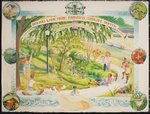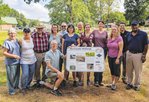


SILER CITY — At Boling Lane Park, recently-planted trees, shrubs and plantings are showing evidence of taking root. And with each passing year, the park’s vegetative buffer will continue to grow, demonstrating best practices for stormwater management and enhancing the water quality of Loves Creek, a tributary of which flows through the park.
To celebrate the park’s growth, the Loves Creek Watershed Stewards presented a scenic illustration of what the park’s vegetation buffer will look like in 10 years to the Siler City Board of Commissioners on Monday. The illustration was created by artist Travis Cohn of SpEYEdr Graphics and Illustration who has a studio in Siler City.
The Loves Creek Watershed Stewards were formed in 2014 to “restore the ecological function” of Loves Creek and “provide economic and community health benefits,” according to the group. Members include stakeholders from federal, state and local agencies as well as businesses, local citizens and non-profit groups. Biocenosis’ Catherine Deininger and Karen Hall, along with the Piedmont Conservation Council’s Grace Messinger, are the group’s project leaders. The group is focused on Loves Creek because as an impaired stream designated by the federal Environmental Protection Agency, there are funds available to support efforts to restore areas around the watershed. To date, the group has worked on eight projects in the watershed which have resulted in $788,667 in grant funding.
Boling Lane Park, located on Fir Avenue, was the first project.
The group decided its first task was to address stormwater issues at the park. The park suffered regular flooding during rain events. Stormwater pipes drained directly into the creek which flows through the park, adding pollutants and runoff into the impaired waterway. At the same time, Siler City town staff regularly mowed the stream banks of the creek, which “exacerbated the stormwater runoff issues and reduced aquatic life habitat.” Since the park was frequently used by residents of all ages, the Stewards thought this would be the group’s best starting point.
The group secured the support of the town as well as a $150,000 grant awarded to the Piedmont Conservation Council by the EPA. They also secured a reimbursement from the Chatham County Soil and Water Conservation District. Between grants, in-kind contributions, donations and volunteers, the group collected just over $250,000 for the project.
Goals
The project included the creation of two stormwater wetlands of about .12 acres to capture stormwater runoff from the parking lot and adjacent roads. Wetlands can serve as a water treatment, filtering nutrients and chemicals before reaching open water. About 244 feet of pipe was rerouted to discharge into the wetlands and about 5,500 native plants were planted in and around the wetlands with community volunteers contributing more than 134 hours.
The group also created 1,040-foot long, 15-foot wide riparian buffer along the creek within Boling Lane Park to reduce stormwater runoff pollution and habitat degradation. As the presence and health of insects and other biological bodies help determine the degree to which a water is impaired, the group assessed the abundance of aquatic insect life in the creek both before and after installation of wetlands and creek buffer.
And finally, the group wanted to provide outreach and education to the local community about the project and its benefits. The group performed pre-construction tours in August of 2016 and 2017 during “National Night Out” event. It also offered a public tour in June 2018 following construction and created four educational signs that have been installed at Boling Lane Park. They include educational information and pictures depicting the purpose of Stormwater Wetlands, Stream Buffers, Aquatic Plants and Helpful Mosquito Predators. All signs have a QR code linked to Town of Siler City-Loves Creek Watershed Stewards which then translates the information into Spanish.
Challenges
Though the goals were worthwhile and the funding was secured, there were still challenges for the Stewards. According to Deininger, the biggest hurdle was “getting the community to better understand why the project was implemented and how it will benefit the community.” Misunderstandings in the community about the project led to complaints from residents about what was perceived as unkempt weeds and fears of snakes and mosquitoes breeding in the wetlands.
“It is an ecosystem in process and it will take time for trees to grow,” Deininger said. “Take a closer look at the native vegetation and you see a thriving diverse community of plants and animals. This healthy ecosystem is helping reduce flooding issues in the park while at the same time providing rich new habitat for a wide variety of plant and animals such as birds, amphibians, dragonflies and other aquatic invertebrates.”
Those animals actually help to reduce the existence of nuisance pests such as mosquitoes.
At the same time, the group found that the benefits and rewards far outweigh the challenges encountered. The group found that community volunteerism blossomed through planting native vegetation as well as interaction with and feedback from the neighborhood. They say several neighbors reported they “loved hearing and seeing the frogs that were coming out because of the wetlands.” Others positively remarked on the beautiful wildflowers growing in the wetland areas, according to the group.
“Boling Lane Park is a place where people can now experience the nature of wetland habitats while taking their daily walk,” Deininger said. “When they see a dragonfly zoom by or a tree frog sunning near the wetlands they can tell their children that the creek is healthy.”
For the town
“Town staff and elective officials have been open to nearly all ideas of improving water quality and addressing watershed issues,” Deininger said. “This has made working the Loves Creek watershed truly a team effort. At the same time, the town has challenged us to not just focus on restoring Loves Creek, but to integrate improvement of the economic and community health with watershed stewardship. The Loves Creek Watershed Stewards will continue working towards the goals of water quality improvement, economic growth, community health awareness, and environmental education for years to come.”
The Loves Creek Watershed Stewards showed their gratitude for the support of the town by presenting the original illustration to the Siler City commissioners on Monday.
“I want to thank you,” Mayor Pro-Tem Larry Cheek said in Mayor John Grimes’ absence. “You certainly worked hard. This is a signal of what can happen when we work together.”
Commissioner Chip Price signaled that it might be nice to put the image at the park, but as it was an original artwork, Deininger suggested she use one of the high quality PDFs to create something that could be placed at Boling Lane Park, an idea the board appeared to appreciate.
The work continues
The Loves Creek Watershed Stewards continue to work on other projects in Siler City to improve the water quality of the creek. The Piedmont Conversation Council and Biocenosis, along with Kris Bass Engineering, which is working with Town of Siler City and the Stewards, has secured funding to acquire four under-utilized parcels in town along the railroad and Loves Creek, amounting to six acres. The properties will be cleaned up of exotic, invasive plants like kudzu and piles of debris and garbage left on properties will be removed. An old condemned house on Chatham Avenue has already been removed. The existing stream corridor will be restored and a riparian buffer including trees, shrubs, herbaceous plants will be established. Once the major tasks are completed, the property will be turned over to the town to be used as a park or however best the town wants to utilize the reclaimed land. That project will likely not be complete until mid-2021.
The Stewards and other partners are also working to implement stormwater control measures on residential, commercial and town owned properties in the Park Shopping Center sub-watershed area which has suffered after extensive flooding.
“We believe that people are stewards of the earth and are in part responsible for taking care of the environment, including water quality and wildlife habitat,” the Loves Creek Watershed Stewards said in a statement. “We lead by example so that future generations can carry on this important work.”
Reporter Casey Mann can be reached at CaseyMann@Chathamnr.com.